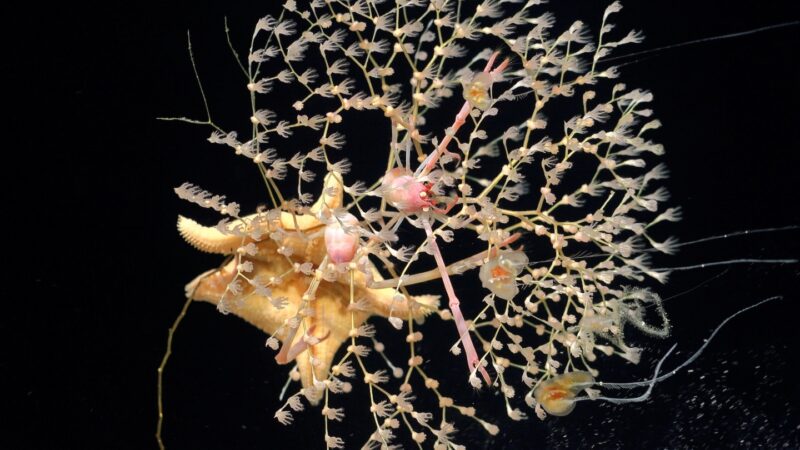
anemone: (in zoology) Known as sea anemones, these soft, gelatinous invertebrates have a tubular body and one or more circles of venomous tentacles surrounding their mouths. These carnivorous animals tend to live glued to rocks on the seafloor, where they feed on plankton and tiny fish. Resembling a flower, an anemone can range in size from less than 2.5 centimeters (an inch) to some 1.5 meters (5 feet) across.
coral: Marine animals that often produce a hard and stony exoskeleton and tend to live on reefs (the exoskeletons of dead ancestor corals).
ecosystem: A group of interacting living organisms — including microorganisms, plants and animals — and their physical environment within a particular climate. Examples include tropical reefs, rainforests, alpine meadows and polar tundra.
expedition: A journey (usually relatively long or over a great distance) that a group of people take for some defined purpose, such as to map a region’s plant life or to study the local microclimate.
footage: (in movies and videos) A term for the uncut or unprocessed motion pictures or video imagery taken by a camera. It takes its name from the fact that it took several feet of film to capture a few seconds of motion-picture photography.
fossil: Any preserved remains or traces of ancient life. There are many different types of fossils: The bones and other body parts of dinosaurs are called “body fossils.” Things like footprints are called “trace fossils.” Even specimens of dinosaur poop are fossils. The process of forming fossils is called fossilization.
oceanographer: Someone who works in the branch of science that deals with the physical and biological properties and phenomena of the oceans.
octopus: (pl. octopi or octopuses) Sea mollusks with a soft, sac-shaped body and eight arms. Two rows of suckers along each arm give the animal an ability to grasp and hold onto things. Cousins of the squids, these animals have a sharp beak-like mouth and good vision.
organism: Any living thing, from elephants and plants to bacteria and other types of single-celled life.
Pacific: The largest of the world’s five oceans. It separates Asia and Australia to the west from North and South America to the east.
pectoral: fins The fins that emerge from the side of a fish, just behind its head. They help direct the animal’s motion. They effectively correspond to the arms (or forelimbs) of a land animal.
reef: A ridge of rock, coral or sand. It rises up from the seafloor and may come to just above or just under the water’s surface.
robot: A machine that can sense its environment, process information and respond with specific actions. Some robots can act without any human input, while others are guided by a human.
satellite: A moon orbiting a planet or a vehicle or other manufactured object that orbits some celestial body in space.
sea: An ocean (or region that is part of an ocean). Unlike lakes and streams, seawater — or ocean water — is salty.
seamount: A mountain (usually formed by a volcano) whose entire structure sits below the surface of the ocean. If it broke the surface, it would become an island.
species: A group of similar organisms capable of producing offspring that can survive and reproduce.
sponge: Something that sops up liquids or other materials and holds them until squeezed out or removed in some other way. (in biology) A primitive aquatic animal with a soft, porous body.
squid: A member of the cephalopod family (which also contains octopuses and cuttlefish). These predatory animals, which are not fish, contain eight arms, no bones, two tentacles that catch food and a defined head. The animal breathes through gills. It swims by expelling jets of water from beneath its head and then waving finlike tissue that is part of its mantle, a muscular organ. Like an octopus, it may mask its presence by releasing a cloud of “ink.”
summit: (in geology) The uppermost part of a mountain or hill, or (verb) the act of climbing and reaching that uppermost point.
survey: To view, examine, measure or evaluate something, often land or broad aspects of a landscape. (with people) To ask questions that glean data on the opinions, practices (such as dining or sleeping habits), knowledge or skills of a broad range of people. Researchers select the number and types of people questioned in hopes that the answers these individuals give will be representative of others who are their age, belong to the same ethnic group or live in the same region. (n.) The list of questions that will be offered to glean those data.
urchin: Small, spine-covered sea animals without eyes or limbs which are related to sand dollars and starfish.
whale: A common, but fairly imprecise, term for a class of large mammals that lives in the ocean. This group includes dolphins and porpoises.
